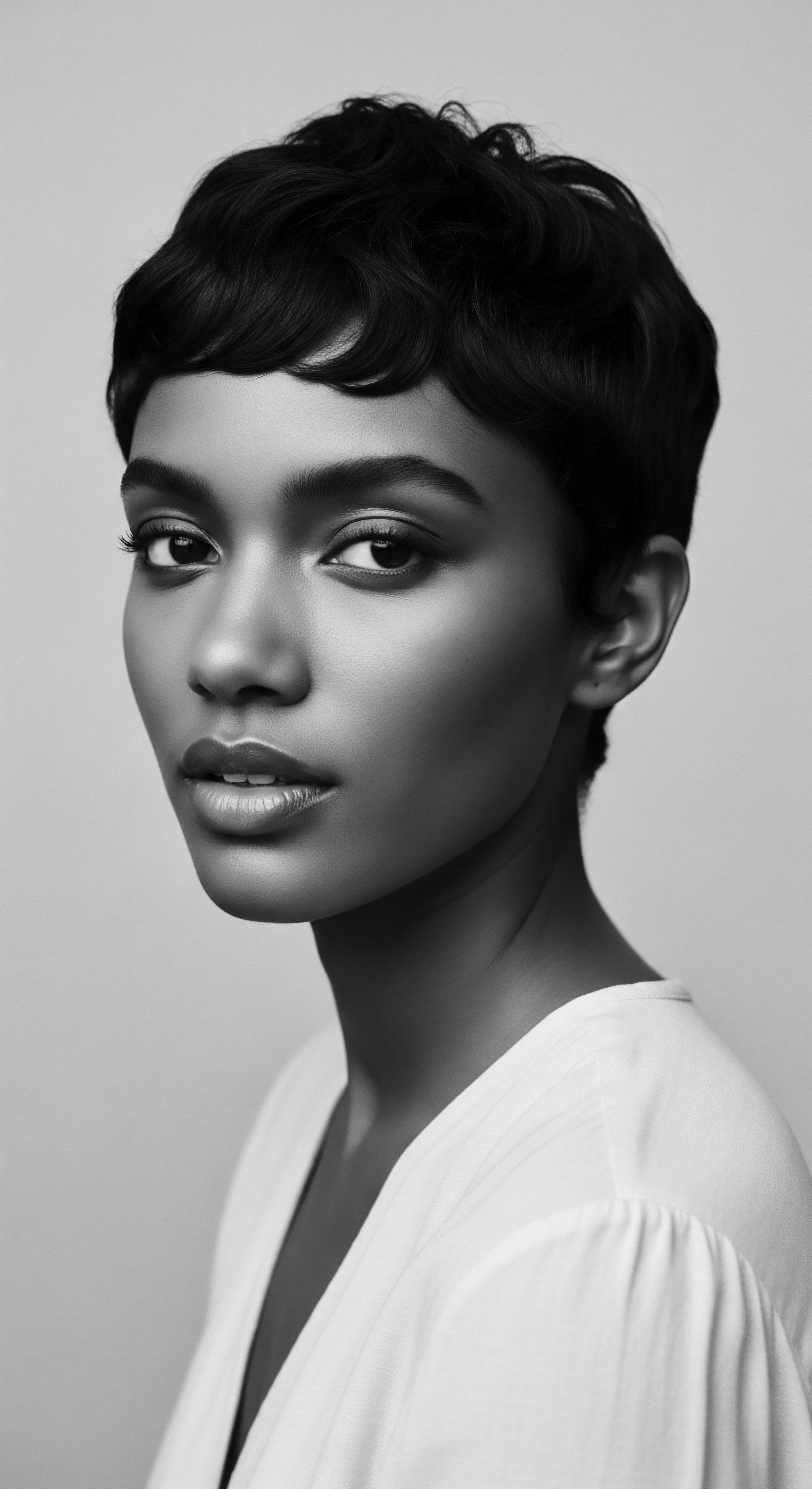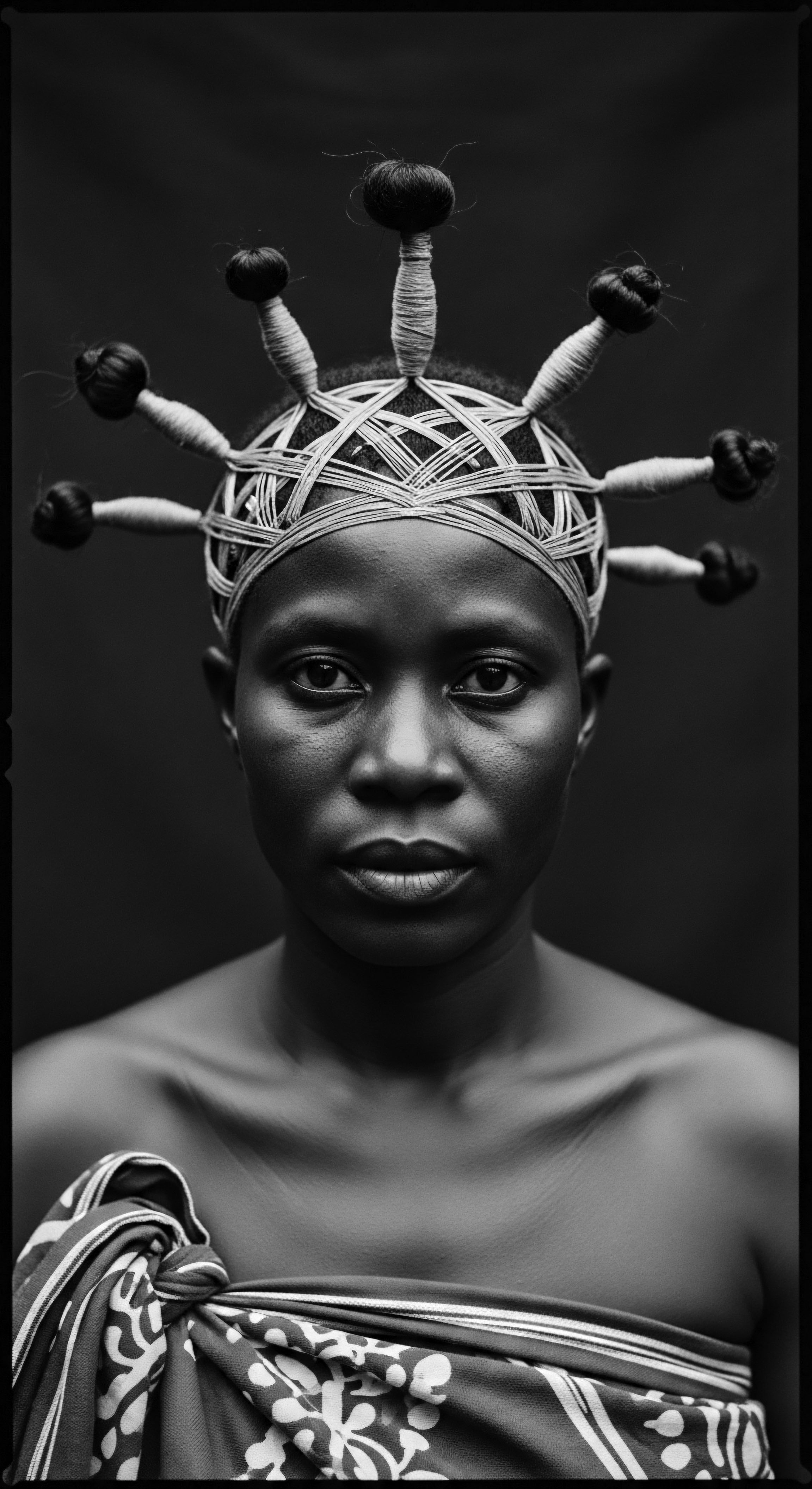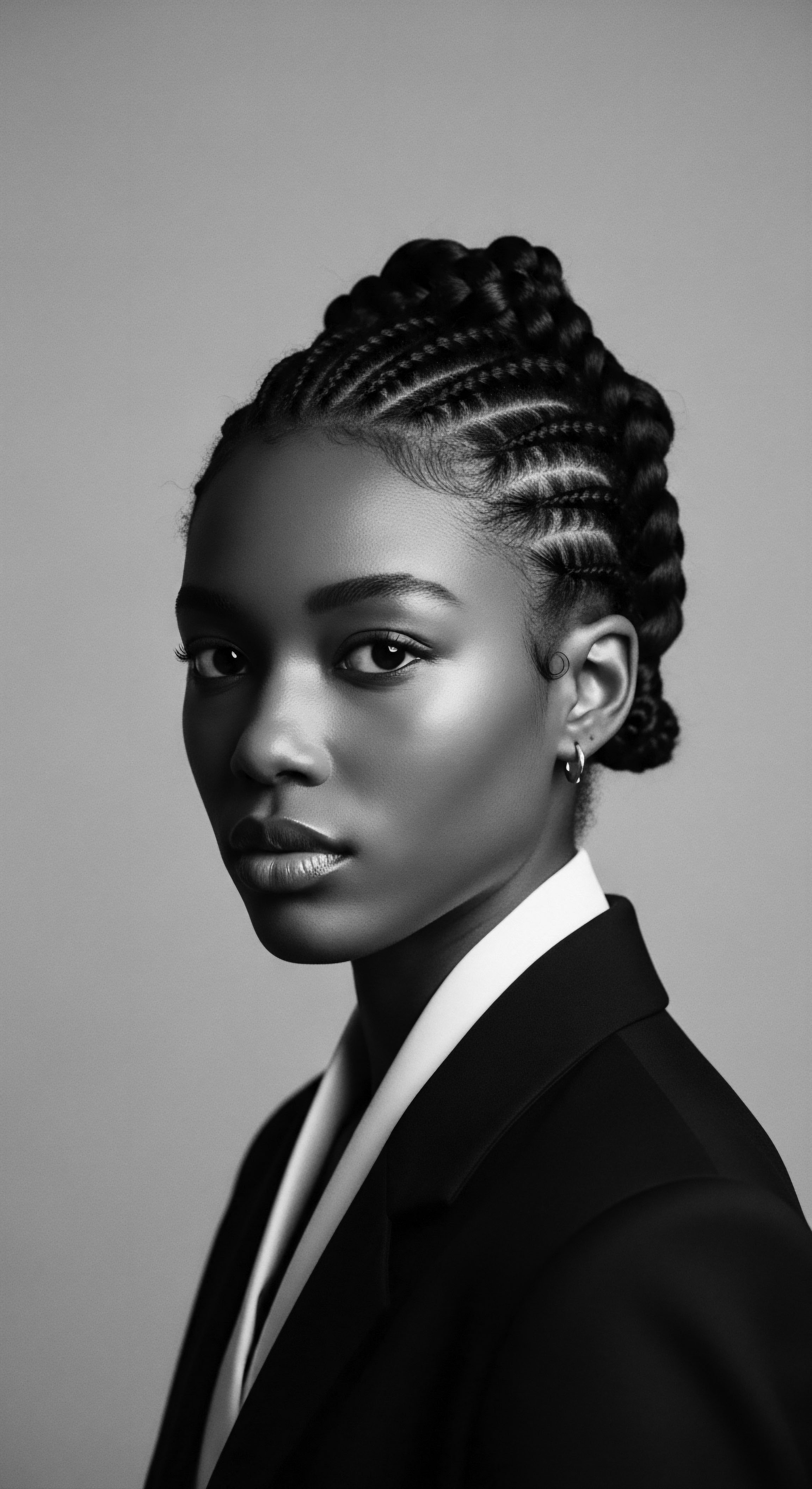
Roots
To truly understand the whispers of the strand, particularly those of low porosity textured hair, one must first listen to the echoes from ancient riverbeds and sun-drenched savannas. Our hair, a living extension of our lineage, carries within its very helix the wisdom of generations who intimately knew the earth’s bounty. It speaks a language of resilience, of adaptation, and of beauty born from deep connection to source. As we seek to discern which oils best serve this unique architecture, we journey back through time, allowing the hands of our ancestors to guide our sight.

Hair’s Elemental Blueprint
Consider the hair strand ❉ a remarkable feat of natural engineering. Its core, the cortex, holds the strength and pigment. Surrounding this, the cuticle acts as a protective shield, a series of overlapping scales, much like shingles on a roof. For those with low porosity textured hair, these scales lie tightly bound, resisting the entry of moisture.
This characteristic, often inherited, means that while moisture once inside stays put, getting it there requires a tender strategy. It is akin to a precious, well-sealed vessel. Water and larger molecules might bead on the surface, unable to breach the firm outer layer. Understanding this microscopic reality, a truth known intuitively by those who cared for hair across millennia, is the beginning of purposeful care.
Low porosity textured hair, with its tightly sealed cuticle, requires specific light oils that can gently penetrate its protective outer layer.
Ancestral communities, without the aid of microscopes, understood this through observation and generations of trial. They noted how certain plant extracts and animal fats behaved on different hair types, discerning which offerings the hair seemed to accept and which it simply repelled. This deep, experiential knowledge formed the bedrock of hair care practices, long before the lexicon of ‘porosity’ found its way into modern science. The hair was a barometer of health, a canvas for storytelling, and its treatment was a sacred act, aligning bodily wellness with the rhythms of the earth.

Classifying Hair’s Ancient Textures
The ways in which hair was categorized by our foremothers stretched beyond mere visual assessment. It was often linked to tribal identity, social standing, and life stages. While contemporary systems categorize hair into numbers and letters, often struggling to fully capture the complexity of textured hair, our ancestors observed the hair’s spirit ❉ its spring, its resistance, its thirst.
The recognition of hair that seemed to absorb less, holding onto moisture for longer once damp, was an observation that shaped the choice of lighter, more fluid oils. This wisdom, passed down through the generations, predates any Western scientific attempts at classification.

Ancestral Lexicon of Hair Care
Many words and traditions from African and Afro-diasporic cultures speak to the intimate relationship with hair. Terms for hair braiding, for instance, are numerous and region-specific, reflecting the depth of practice. The application of oils was often tied to names that signified health, growth, or communal bonding. This linguistic heritage reminds us that hair care was never a detached, clinical act.
It was embedded in daily life, communal gatherings, and rites of passage. The knowledge of which plant yields the ‘softest oil’ or the ‘most protective balm’ was a living, breathing part of cultural vernacular.

Oils and the Ancestral Veil
The choice of oils for hair that resisted penetration was a pragmatic one, honed by centuries of observation. The heavy, viscous oils might coat the surface, leading to limpness or a greasy feel, a common frustration even today for those with low porosity strands. But lighter, molecularly smaller oils found their way, imparting pliability and a subtle sheen. In the Sahel, for example, the nourishing properties of Moringa Oil, pressed from the seeds of the ‘miracle tree,’ might have been revered for its capacity to condition hair without weighing it down.
Similarly, the use of Baobab Oil, often referred to as ‘The Tree of Life’ oil, from southern Africa, with its relatively light texture and richness in fatty acids, would have been intuitively selected for hair that needed deeper penetration. These botanical essences, deeply connected to the land and its people, were not just cosmetic; they were extensions of a holistic worldview, where sustenance came directly from the natural world.

Ritual
The transition from elemental understanding to the living practice of hair care is where ritual takes hold. For textured hair, particularly those strands with low porosity, the application of oils moved beyond simple function; it blossomed into a sequence of deliberate, repeated actions that affirmed identity, cultivated connection, and preserved an ancestral legacy. This wasn’t merely about conditioning the hair; it was about honoring its place in the world.

Oiling as a Sacred Practice Through Time
Across African societies, oiling the hair and scalp held profound cultural and spiritual weight. It was a practice woven into the fabric of daily life, from infancy to old age. The act of applying oils was often performed by elder women, imparting not only botanical sustenance but also wisdom and blessing onto the younger generation. It was a moment of intimate connection, a tender exchange that reinforced familial bonds and cultural values.
This sacred practice, far from a fleeting trend, speaks to a continuity of care that has protected and celebrated textured hair for millennia. For low porosity hair, this methodical, gentle application meant the lightweight oils had a chance to work their way into the resistant cuticles, not simply sit on the surface.
The ceremonial application of oils in ancestral practices ensured deeper absorption into low porosity hair, intertwining care with cultural significance.
Consider the historical accounts of hair oiling in ancient Egypt, where elaborate hair preparations were common. Though not exclusively low porosity hair, the emphasis on luxurious, penetrating oils for maintenance and styling reflects a sophisticated understanding of hair’s needs. Ingredients like Moringa Oil and Castor Oil (though heavier, often diluted or used sparingly for low porosity in specific contexts) were documented components of beauty rituals, often blended with fragrant resins.
Kedi, in Beautifying the Body in Ancient Africa and Today (2010), highlights the deep significance of hair care, noting its spiritual importance in ancient Nubian cultures. This suggests that the selection and application of oils were informed by principles that transcended mere aesthetics, touching upon the hair’s very health and energetic state.

Protective Styling and Oil’s Enduring Role
Protective styles are a cornerstone of textured hair heritage, serving as both artistic expression and practical preservation. Braids, twists, and coils, in their myriad forms, offered protection from environmental stressors and minimized daily manipulation. Oils were, and remain, an indispensable companion to these styles.
For low porosity hair, the careful application of lighter oils before braiding or twisting helped to seal in moisture and reduce friction, preventing breakage without causing heavy build-up that could unravel the style or lead to residue. This ensured the longevity of the style and the health of the strands underneath.
- Jojoba Oil ❉ Revered for its molecular similarity to the hair’s natural sebum, making it highly compatible and easily absorbed by low porosity hair.
- Argan Oil ❉ A golden elixir from Morocco, valued for its light texture and ability to add sheen without heaviness.
- Grapeseed Oil ❉ A very light oil, prized for its non-greasy feel and capacity to deliver moisture without coating the hair.

Tools of Tender Care
The tools used in ancestral hair care were extensions of the hand, crafted with purpose and reverence. Carved wooden combs, often adorned with symbolic motifs, were used not only to detangle but also to distribute oils evenly from root to tip. The rhythmic motion of combing and oiling was a meditation, a dance between caregiver and receiver.
For low porosity hair, this precise application method, coupled with the gentle warmth of the scalp, aided in the subtle opening of the cuticles, allowing the beneficial oils to penetrate rather than simply sit on the surface. These practices, deeply embedded in cultural memory, continue to inform contemporary techniques for optimal product delivery.
| Traditional Oil Source (Region) Moringa Oil (Sahel, East Africa) |
| Ancestral Observation / Use Used for its lightness and capacity to 'soften' hair and scalp, preventing dryness. |
| Modern Scientific Relevance for Low Porosity Rich in behenic acid, a lightweight fatty acid, allowing for better penetration into low porosity cuticles without residue. |
| Traditional Oil Source (Region) Baobab Oil (Southern Africa) |
| Ancestral Observation / Use A prized 'tree of life' oil, known for its ability to condition without weight, promoting pliability. |
| Modern Scientific Relevance for Low Porosity Contains palmitic, oleic, and linoleic acids in a balanced ratio, contributing to its light feel and capacity to moisturize resistant hair. |
| Traditional Oil Source (Region) Sweet Almond Oil (Middle East, North Africa) |
| Ancestral Observation / Use Valued for its soothing properties on the scalp and ability to add luster to hair. |
| Modern Scientific Relevance for Low Porosity A light, non-comedogenic oil with good spreadability, making it suitable for sealing moisture into low porosity hair without buildup. |
| Traditional Oil Source (Region) These oils, long part of hair heritage, demonstrate a continuity of effective care for low porosity textures across time. |

The Transformation Through Generations
The ritualistic application of oils, tied to styling, served a deeper purpose ❉ the preservation of identity. Through periods of immense historical upheaval, particularly during the transatlantic slave trade and its aftermath, hair became a powerful symbol of defiance and cultural continuity. The forced denial of traditional hair practices, including the use of specific oils, was a tool of dehumanization. Yet, despite these challenges, the knowledge of which oils to seek, how to apply them, and how to style hair to protect it persisted, passed down in whispers and through observation.
Byrd and Tharps, in Hair Story ❉ Untangling the Roots of Black Hair in America (2001), chronicle how enslaved individuals repurposed available materials, sometimes even axle grease, for hair care, a stark reminder of the resilience of these practices even when traditional oils were inaccessible. This legacy of adaptation and resistance, often centered around hair and its care, shaped not just individual identity but the collective spirit of a people. The oils became not merely emollients but conduits of cultural memory.

Relay
Our modern understanding of low porosity textured hair stands on the shoulders of this vast heritage, a relay race of wisdom passed through countless hands. The quest for which oils suit low porosity hair best is not a contemporary invention; it is a continuation of an ancient dialogue between humanity and the botanical world, now amplified by scientific insight. This dialogue allows us to connect the molecular structure of oils to the very specific needs of a hair type that has, for centuries, presented its unique set of beautiful challenges.

Building a Regimen from Generations
Crafting an effective hair care regimen for low porosity textured hair today involves a respectful synthesis of ancestral wisdom and modern scientific validation. The core principle, recognized by generations, is gentle consistency. For hair that struggles to absorb moisture, a regimen that prioritizes pre-pooing with lightweight oils, followed by thorough cleansing and conditioning, proves most effective. The ancestral practice of coating hair before cleansing, often with plant extracts, finds validation in studies showing that certain oils can reduce hygral fatigue – the swelling and shrinking that occurs when hair repeatedly gets wet and dries, a particular concern for low porosity strands.
Rele and Mohile (2003) conducted a study which found that coconut oil, due to its molecular structure, could penetrate the hair shaft, reducing protein loss for both damaged and undamaged hair. While some with low porosity hair find coconut oil too heavy, this research points to the historical efficacy of lighter, penetrating oils in preserving hair integrity.

The Nighttime Sanctum and Oil Preservation
The ritual of protecting hair at night, a practice often dismissed as a modern invention, is deeply rooted in ancestral wisdom. From intricate headwraps worn by African women for protection and beauty to the pragmatic coverings adopted during enslavement to preserve hair from dust and damage, the recognition of nighttime as a period for restoration is a powerful thread in textured hair heritage. For low porosity hair, this nighttime sanctuary, often complemented by a light application of suitable oils, becomes a critical act of moisture retention.
The protective barrier of a silk or satin bonnet, a contemporary iteration of historical head coverings, prevents friction and allows applied oils to slowly permeate the hair shaft, rather than being lost to fabric absorption. This sustained environment supports the delicate process of hydration for resistant cuticles.

Herbal Alchemy ❉ Ancestral Oil Wisdom Validated
The ancestral pharmacy offered a range of botanical oils, each revered for specific qualities. Modern science, through techniques like gas chromatography and mass spectrometry, now confirms many of these long-held beliefs, revealing the precise fatty acid profiles that make certain oils ideal for low porosity hair.
- Jojoba Oil ❉ A liquid wax, not a true oil, its chemical structure is remarkably similar to the natural sebum produced by the scalp. This biomimicry allows it to readily penetrate the cuticle of low porosity hair, providing moisture and balance without leaving a greasy film. Its lightweight nature helps prevent product build-up, a common issue.
- Argan Oil ❉ Hailing from the argan tree in Morocco, this golden oil is rich in oleic and linoleic acids. Its relatively small molecular size allows it to glide over and gently slip past the tightly closed cuticles, imparting a luminous sheen and softening the hair without heaviness.
- Grapeseed Oil ❉ Extracted from the seeds of grapes, this oil is exceptionally light and non-greasy. It is high in linoleic acid and offers subtle conditioning without weighing down low porosity strands, making it an excellent sealant.
- Sweet Almond Oil ❉ A gentle, nourishing oil, it contains monounsaturated fatty acids which contribute to its relatively light texture. It helps to seal moisture into the hair, providing softness and reducing dryness for low porosity hair types.
These oils, often extracted through traditional cold-pressing methods, carry the very essence of the plant, retaining beneficial compounds that support hair health from a molecular perspective.

Addressing Hair’s Whispers ❉ Product Buildup and Hydration?
For low porosity hair, the very characteristic that keeps moisture locked in can also lead to frustration ❉ product accumulation. Heavier oils or products with large molecules tend to sit on the surface, causing dullness, limpness, and an inability for true moisture to enter. The ancestral response to this was often the judicious use of lighter oils, combined with regular, gentle cleansing methods. Today, this translates to prioritizing clarifying shampoos when needed and selecting oils that are known for their lightness and ability to penetrate.
The New York Society of Cosmetic Chemists (NYSCC) notes that for low porosity hair, treatments may sit on the hair surface, rather than sinking in, reinforcing the need for specific formulations. They also suggest avoiding heavy butters and protein treatments that may build up. This modern scientific understanding aligns with the intuitive ancestral knowledge that certain natural ingredients were simply ‘too heavy’ for some hair types, leading to counterproductive outcomes.

Holistic Wellbeing and Hair’s Inheritance
The care of textured hair, particularly for low porosity types, extends beyond the topical application of oils. It is a holistic endeavor, deeply tied to physical, emotional, and spiritual wellbeing, a truth known to our ancestors. Diet, hydration, and stress management all play roles in the health of the strands. The oils chosen, therefore, were not isolated remedies but part of a larger wellness philosophy.
A balanced internal state supported the hair’s capacity to receive and retain nourishment. This ancestral perspective, where inner harmony mirrored outer radiance, remains profoundly relevant. The act of caring for one’s low porosity hair with oils best suited for its structure becomes a daily affirmation of self-care, a quiet nod to the wisdom that flows through our collective heritage.

Reflection
The journey to understanding which oils suit low porosity textured hair best is, in truth, a journey into the enduring soul of a strand. It is a recognition that the helix of our hair carries not only genetic codes but also the living archive of our collective past. From the elemental biology of the tightly sealed cuticle to the deliberate, ritualistic application of botanical essences, the story of care for textured hair is a testament to human ingenuity, resilience, and profound connection to the natural world. Our ancestors, through generations of keen observation and intuitive wisdom, identified and utilized lighter, more penetrating oils, long before science could quantify ‘porosity.’
As we continue to explore and refine our understanding, we are not merely seeking products; we are honoring a legacy. Each drop of carefully chosen oil, applied with intention to low porosity strands, becomes a bridge across time, connecting us to the tender hands that first gleaned wisdom from the earth. The care of textured hair stands as a vibrant, living testament to a heritage that refused to be silenced, a narrative of beauty and strength that continues to write itself into the future.

References
- Byrd, Ayana D. and Lori L. Tharps. Hair Story ❉ Untangling the Roots of Black Hair in America. St. Martin’s Press, 2001.
- Dabiri, Emma. Twisted ❉ The Tangled History of Black Hair Culture. HarperCollins, 2019.
- Kedi, Christelle. Beautifying the Body in Ancient Africa and Today. Books of Africa, 2010.
- NYSCC. “An Overview on Hair Porosity.” New York Society of Cosmetic Chemists, 11 Nov. 2020.
- Rele, Vidula G. and R. B. Mohile. “Effect of Mineral Oil, Sunflower Oil, and Coconut Oil on Prevention of Hair Damage.” Journal of Cosmetic Science, vol. 54, no. 2, 2003, pp. 175-192.
